Socotra Travel Guide
This is a Socotra Travel Guide by taste2travel.com
Date Visited: September 2022
Introduction
While a civil war rages on in Yemen, there is one part of that country which is completely safe to visit – Socotra.

The stunning beach, which I had to myself, at Detwah Lagoon.
Visas are required by almost all nationalities (see the ‘Visa Requirements‘ section below for more details) and can only be obtained through local tour operators, once you have signed up for a tour.
The only way of visiting Socotra is by joining an all-inclusive, 8-day, camping tour. The tours correspond with the once-per-week UAE government charter flight from Abu Dhabi, which operates each Tuesday.
As of September 2022, the cost of an 8-day tour, plus return airfare from Abu Dhabi is US$2,360 (1 pax tour) or US$1,910 (2 or more pax sharing a tour).
All costs have to be paid in USD cash, although there is an option to pay for your flight via bank transfer. Full details on all of this are included in the sections below.

Arher beach is a typical Socotran beach – spectacularly beautiful and completely deserted.
Socotra is an ancient land which broke away from the African mainland in the days of Gondwana.
Despite being located alongside one of the busiest shipping channels in the world, at the point where the Indian Ocean and the Arabian Sea meet, Socotra remains firmly off-the-grid, with the locals living a traditional life which hasn’t changed for centuries.
Arriving on Socotra from the glitzy, modern, world of Abu Dhabi is definitely a culture shock! Travelling to the island is like travelling through a wormhole – back into a way of life which existed in the 19th century!

Bottle trees come in all shapes and sizes.
Socotra is a sparsely populated, mostly undeveloped island, which is home to about 50,000 souls, most of whom live in traditional villages.
The only places on the island where you will find electricity are the two towns – Hadiboh and Qalansiya, which have a combined population of 12,000 souls and many more goats.
Elsewhere, some villages have solar panels and are able to generate some electricity.

Would you like to have this beach to yourself? Detwah Lagoon beach, Socotra.
The only accommodation, shops, banks and services are in Hadiboh. If you require something as simple as a power outlet for charging anything (e.g. camera batteries), you will need to return to either Hadiboh or Qalansiya.
As for communications – internet and telephone signal is almost non-existent on Socotra. The only signal towers are in the two towns but even there, the Wi-Fi signal is very weak.
Outside of the towns, the only chance locals have of getting a phone signal is by driving to a high point. They all know the places which provide the best signal.

Hayf and Zahek Sand Dunes are a highlight of the south coast of Socotra.
A trip to Socotra is all about disconnecting from the outside world and forgetting about making daily updates to your Instagram Story. The only time I could reconnect to the internet was upon my return to Abu Dhabi.

A swimming pool to myself at beautiful Wadi Kalysan.
From the weird flora, to the most spectacular of landscapes, Socotra offers plenty of jaw-droppingly beautiful sights. This is an island which is renowned for its strange, otherworldly landscapes – unlike anywhere else on planet Earth.

Beautiful Hala beach, a typical beach on the east coast of Socotra.
Recognising the significance of the island to humanity, UNESCO declared all of Socotra a UNESCO World Heritage Site in 2008.

The Dragon’s blood tree is THE iconic image of Socotra Island.
Socotra is an ancient land with alien landscapes – a dazzling gem in the Indian Ocean, which remains largely untouched and unaffected by the modern world – a rewarding travel destination for truly intrepid travellers!
Location
Hadiboh, Yemen
Socotra is an island of the Republic of Yemen in the Indian Ocean. Despite Yemen being a part of the Middle East, Socotra, which lies off the coast of Somalia, and is an extension of the African continent, is considered to be a part of Africa.
Socotra is the largest of the four islands in the Socotra archipelago and represents around 95% of the landmass of the archipelago.

Socotra is famous for its ‘otherworldly’ landscapes.
The island lies 380 km (240 mi) south of the Arabian Peninsula, and measures 132 km (82 mi) in length and 50 km (31 mi) in width. Somalia lies 400 km (250 mi) to the west.

No shortage of stunning beaches on Socotra.
Geography

The vast limestone plateau rises up from the narrow coastal plain on the south coast of Socotra.
Socotra has three geographical terrains: the narrow coastal plains, a limestone plateau and the lofty Hajhir Mountains (1,503 metres (4,931 ft), which rise up behind the main town of Hadiboh.

A large limestone ridge, Socotra is home to many fine white sand beaches.
Safety

Despite an ongoing war on the Yemen mainland, Socotra is safe, peaceful and very inviting.
Is Socotra safe to visit? Yes!
Despite the ongoing war on mainland Yemen, Socotra exists in isolated, peaceful bliss. It is completely safe to visit.

Young girls on Socotra.
The local Soqotri people are very welcoming and friendly and love seeing tourists on their island.
Independent Travel

Exploring the south coast of Socotra with Socotra Eco-Tours.
Can you travel independently to Socotra? Not really!
In order to get a visa, and hence a flight ticket, you will need to join an organised tour, run by a local tour operator on Socotra.
Socotra Tour Operator

My tour team from Eco-Tours (left – right), Ali (the guide), Abdulrahman (the driver) and Mohammed (Trainee Guide).
I travelled to Socotra with Socotra Eco-Tours who charge US$1,500 for an 8-day itinerary for a single traveller, or US$1050 for 2 or more travellers.

Tiny Hala beach – one of many amazing beaches on Socotra Island.
The tour cost includes visa, meals, accommodation (rough camping), driver and guide. It is fully escorted from airport pick-up to drop-off.
As a solo traveller, I was free to design my own itinerary.
Socotra tour operators provide tents and bedding plus meals. All campsites are in beautiful locations but mostly have no facilities.

A rainbow over Socotra.
Contacts Details for Eco-Tours
Email: holidays
Socotra, Hadibo
Republic of Yemen
P.O. Box 111
Telephone: +967 777 007 588 (also WhatsApp)
Website: https://www.socotra-eco-tours.com/

This splendid wadi served as our lunch and bath spot on one day of our camping trip.
Socotra Flights

The weekly Socotra – Abu Dhabi flight at Socotra Airport.
There are currently two options for reaching Socotra:
- A weekly flight with Yemenia from Cairo (via mainland Yemen)
- A weekly, direct, flight from Abu Dhabi.
If you wish to fly on the Yemenia flight and are having trouble booking a ticket, you can book through Socotra Eco-Tours who act as an agent for the airline.
I flew from Abu Dhabi on what is a UAE Government charter flight which is operated by Emirates Aviation Services (not related to the more famous Emirates Airlines) who use an Air Arabia plane for the service.
The flight operates every Tuesday, leaving Abu Dhabi (Terminal 1) in the morning, returning later in the afternoon. The flight time between Abu Dhabi and Socotra is 2 hours, 15 minutes.
Despite a return ticket costing US$860, this special charter flight is very popular, especially with European tour groups. I was told by a representative from the airline that the flight is sold out from October 2022 to May 2023.
I was able to get a last-minute ticket as I flew in September, just ahead of the main tourist season.
Best to book everything in advance!
Flight Schedule (operated by Air Arabia)
- Flight 9G-476 / Depart AUH 09:25 / Arrive SCT 10:40
- Flight 9G-477 / Depart SCT 12:10 / Arrive AUH 15:25
Contacts Details for Emirates Aviation Services
Telephone: +971 50 671 6175 (also WhatsApp)
Contact Name: Abdulla Yousef
Travel Season

September on Socotra is a wonderful time to visit – before the main tourist season begins.
The best time to travel to Socotra is from September to May. This is when the weather is most stable, although December is the wettest month.
While the weekly flight is reliable from September to May, flights at other times of the year are less reliable, due to strong winds and unfavourable weather.
Travel Costs

The two biggest expenses when travelling to Socotra are the cost of a tour and the airfare.
When travelling to Socotra, the two main expenses are the flight and the tour cost. As outlined in the previous section, these are:
- Tour Cost (8-days / All inclusive): US$1,500 (1 pax) or US$1,050 (2 or more pax).
Tour costs must be paid in USD cash upon arrival on Socotra. There are no credit card facilities anywhere on Socotra and banks are almost non-existent.
- Return Flight (from Abu Dhabi): US$860
The flight ticket must be paid for in USD cash at the airport on the day of departure, or via bank transfer. I actually met Abdulla Yousef for a coffee at Dubai Mall and paid him directly for my ticket.
Apart from these costs, a little extra USD cash will be required to cover any incidental costs and tips for the tour driver and guide.
If you wish to stay in a hotel in Hadiboh, rather than rough camping every night, a room at the Diamond hotel costs US$30 per night.
People

A school girl, in the 2nd largest town of Qalansiya.
Quite different to the Yemenis on the mainland, the Soqotri people are a Semitic ethnic group native to Socotra. The island has been settled for at least 2,000 years.

A young girl at Diksam plateau.
The Soqotri currently number around 57,000 with most living in remote, rural communities and in the capital and main town of Hadiboh (pop: 8,500). The 2nd largest town is Qalansiya which lies on the west coast and is home to 4,000 souls.

Very shy children at Diksam plateau.
The inhabitants speak the Soqotri language and are mostly Sunni Muslims.

Women on Socotra are rarely seen and are always covered in public.
The modern age has bypassed Socotra, which retains a very traditional way of life. Electricity, internet and shops can only be found in Hadiboh and Qalansiya.

While Socotra is home to 50,000 souls, the goat population is much larger.
Being a traditional Islamic society, women are rarely seen in public and are always covered. While young girls can be photographed, females older than adolescent age cannot!
Wherever I travelled on Socotra, I was surrounded only by men.
Despite the traditional way of life, some Socotran females travel to Egypt, along with many males from the island, to receive a tertiary education. Almost all attend a college in Alexandria and live in student accommodation before returning home. Some females can be found working in Hadiboh.

Houses on Socotra feature colourfully decorated wrought iron doors and windows.
The overwhelming majority of Socotrans live a traditional rural lifestyle, either fishing or raising livestock (goats, sheep, cattle and camels), which allows them to produce milk and meat for themselves and their community. Commerce on the island is minimal.
Being a close-knit community, everyone knows everyone. Wherever we travelled on Socotra, my driver and guide would often stop to say hello to friends.

My guide Ali, posing with the very cute daughter of a friend, in the town of Qalansiya.
There is a close bond between Soqotri which is the result of living a traditional life, isolated from the rest of the world, free from the distractions of a 21st century lifestyle.
Yemen and South Yemen

A map showing North and South Yemen, prior to unification.
Source: Wikipedia.
For most of its history, what is today a united Yemen was two different entities – North Yemen and South Yemen.
During the colonial era, North Yemen existed as a state in the Ottoman Empire, with Sanaa serving as its capital, while South Yemen was administered by the British as part of British India. Aden served as the capital of South Yemen, which also included Socotra.
While you travel around Socotra, you will see the flag of South Yemen and rarely the flag of Yemen.
During its day, South Yemen had the distinction of being the only avowedly communist nation in the Middle East, receiving generous foreign aid and other assistance from the Soviets.
The two Yemen’s were eventually united on the 22nd of May 1990, becoming the Republic of Yemen.
The ongoing civil war today sees Iranian-backed (Shia) Houthi forces, which control all of North Yemen, fighting against a coalition of Saudi-backed (Sunni) forces which controls South Yemen.
Russian Tanks

One of many rusty Russian T-34 tanks which line the north coast of Socotra.
Despite the fact that Socotra is today safe, during the 1970-90s, the island was part of South Yemen aka Democratic Yemen, which was a pro-USSR communist state.
To protect the island from any potential invasion from the mainland, the USSR installed several dozen old and rusty T-34 tanks (from the days of WWII), along the north coast. Hardly functional at the time they were installed, these tanks served only as gun turrets.
These broken relics can be seen in various places along the northern coastline.
Flags

The flag of the Republic of Yemen.
The flag of the Republic of Yemen was adopted on May 22, 1990, the day that North Yemen and South Yemen were unified.
The flag is essentially the Arab Liberation Flag of 1952, introduced after the Egyptian Revolution of 1952 in which Arab nationalism was a dominant theme. The same flag is today used by Egypt, Iraq, Sudan and Syria.
According to the official description, the red stands for unity and the bloodshed of martyrs, the white for a bright future, and the black for the supposed dark past.
You will rarely see the Yemen flag on Socotra, where the flag of South Yemen is flown instead.

The flag of South Yemen, officially the People’s Democratic Republic of Yemen.
The Flag of South Yemen is the same as that used by the Republic of Yemen (i.e. the Arab Liberation flag) with the addition of a sky-blue chevron and a red star on the hoist side.
The flag was adopted on 30 November 1967 when South Yemen declared independence from the United Kingdom until the Yemeni unification in 1990.
Today, the South Yemeni flag is used by the separatist supporters from the Southern Movement and the Southern Transitional Council. It is this flag which you will see flown on Socotra.
Currency

The official currency of Yemen is the Yemeni rial.
The official currency of Yemen is the Yemeni rial, which has the international currency code of YER.
Banknotes are issued in denominations of 50, 100, 200, 250, 500 and 1,000 rials.
The Yemeni Civil War has caused the currency to diverge.
In southern Yemen, which is primarily controlled by UAE-backed separatists and the former government backed by Saudi Arabia, ongoing printing has caused the currency to plummet into freefall.
In northern Yemen, which is primarily controlled by Ansar Allah with support from Iran, banknotes printed after 2017 are not considered legal tender, and therefore, the exchange rate has remained stable.

1000 Yemeni rial banknotes.
Exchange Rates
Despite the current advertised exchange rate (on Google) of USD$1 = 250 rial, the exchange rate on Socotra at the time of my visit in September 2022 was:
USD$1 = 1,100 rial
Flora
Dragon’s Blood Tree

Dragon’s blood trees at Homhil Plateau Protected Area, Socotra, Yemen.
Most famous and iconic of all Socotri flora is the Socotran dragon’s blood tree (Dracaena cinnabari). While other species of this tree can be found in other parts of Africa and Arabia, the Socotran dragon’s blood tree is endemic to the island.
Since ancient times its red resin, from which the tree gets its name, has been highly desired.

A view of the Firmihin Forest on Diksam plateau.
The most prolific stand of Dragon’s blood trees on Socotra is in the Firmihin Forest on Diksam plateau.

A view of Dragon’s blood trees and the spectacular gorge at Diksam plateau.
However, during my visit the plateau was always shrouded in mist and fog with constant rain fall, making photography tricky.

Dragon’s blood trees on Homhil, Socotra.
The best photo opportunity was on Homhil where the trees were basking in brilliant sunshine.

Young Dragon’s blood trees in a nursery on Diksam plateau.
While there are many fine examples of Dragon’s blood trees on Diksam plateau, the tree is classified as ‘threatened’. It is believed the many roaming goats on the island love to eat the younger trees.
To counter this threat, a team of Czech researchers has established a protected nursery for young Dragon’s blood trees on Diksam plateau, adjacent to the tourist campsite.

My haul of Dragon’s blood tree resin which I purchased from a village on Diksam plateau.
The red resin from the Dragon’s blood tree has been in continuous use since ancient times as incense, medicine, dye and varnish. Today, villagers on Socotra sell packets of resin to passing tourists. The small haul pictured above cost me about US$3.
Socotran Frankincense Tree

Socotran frankincense trees (Boswellia socotrana) at Homhil Plateau Protected Area, Socotra, Yemen.
Frankincense, the resin produced by a species of Boswellia, was one of the most valuable commodities produced in the ancient world. Highly prized as fragrant incense, it was also widely used in medicine, cosmetics, and even cuisine.
Today, large quantities of Frankincense are traded around the world for use in religious ceremonies and for incense production.
Common to the Horn of Africa and the Arabian Peninsula, the species found on Socotra – Boswellia socotrana – is endemic to the island and is said to produce the best quality resin.
The best examples on Socotra can be found in a small grove at the Homhil Plateau Protected Area.
Socotra Bottle Trees

Bottle trees can be found throughout Socotra Island.
If there is one tree which gives Socotra its otherworldly look then it must be the weird and wacky bottle tree.

Bottle trees are easily distinguished by their swollen trunks.
The species found on Socotra is Adenium obesum var socotranum, which is a poisonous plant, which explains why the many goats on the island leave it completely alone.

Pink flowers on a bottle tree.
Bottle trees can be found throughout Socotra, taking root in mostly hard limestone rock on vertical cliffs and high mountain plateaus. They also especially like sloping ground.

Flowering Bottle tree on Socotra.
Each year, especially in March, the trees bloom with big, beautiful pink flowers. During my visit in September, I was able to find several flowering trees.

Bottle trees like to grow in precarious locations.
Aloe Jawiyon

Aloe jawiyon is a species of aloe which is endemic to Socotra.
Aloe jawiyon is a species of aloe which is endemic to Socotra and is used by locals for medicinal purposes.
Birds of Socotra
Socotra Starling

Socotra (female) starling.
The Socotra starling can be found throughout the island and always in mating pairs.
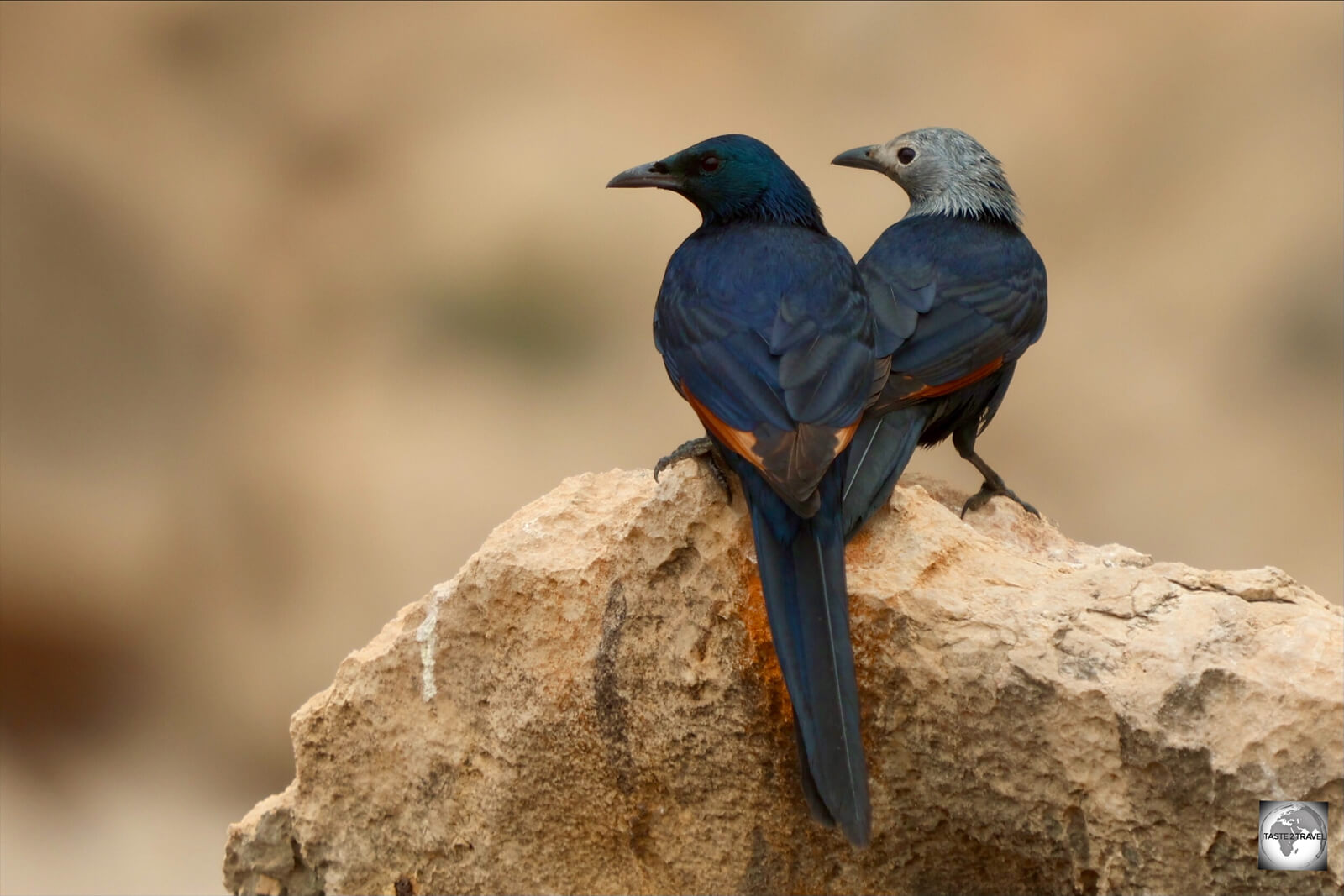
Socotra starlings (male on the left, female on the right) pair for life and can always be seen together.

A female Somali starling at Diksam plateau.
Socotra Sparrow

The Socotra sparrow is endemic to Socotra.
The endemic Socotra sparrow has distinct plumage which sets it apart from most other sparrows.
Egyptian Vulture

The widespread Egyptian vulture is a common sight on Socotra.
Egyptian vultures are widespread throughout Socotra, where they can be seen scavenging off rubbish heaps and anything else they can find.
Despite their name, this species of vulture is widespread and can be found in many regions between Spain in the west and India in the east.

Whenever I ate my meals on Socotra, I was quickly surrounded by Egyptian vultures, who were keen for any scraps.
Whenever meals were served at our campsite, shadows would circle overhead. Egyptian vultures looking for a feed!
Eventually they would settle on the ground around me, waiting for any scraps of food. My fellow dining companions during my week of camping!
Sightseeing

My Socotra Eco-Tours team, (left – right) Mohammed, Abdulrahman and Ali.
During my 8 days on Socotra, I covered the sights listed below on a tour with Socotra Eco-Tours.
I travelled in a Toyota 4WD which was expertly driven by the very capable Abdulrahman, who also served as the cook. The tour was led by my guide, Ali who was supported by a trainee guide, Mohammed, who was on a break from his studies in Alexandria, Egypt.
Hadiboh

Fish vendors at the Central fish market in Hadiboh, Socotra.
The first day of the tour started with my arrival on Socotra from Abu Dhabi. After exiting the airport, we drove into Hadiboh to have lunch at the very busy Shabwah Restaurant.

Fresh tuna, seen here at the Central fish market, is always on the menu on Socotra.
The noisy, chaotic, less-than-hygienic, nature of the restaurant was a complete culture shock after many days spent dining in the ritzy malls of the UAE.

Fresh tuna for sale at the Central fish market in Hadiboh.
The capital and biggest town on Socotra is a collection of non-descript breeze-block buildings which line dusty, chaotic streets which are covered in litter. There is no organised rubbish collection on Socotra.
Hadiboh is small but does have some all-purpose shops, banks and currency-exchange facilities, a handful of café/restaurants, a market and a hospital. There are no shops elsewhere on the island! If you need anything for your week of camping, you need to purchase it in Hadiboh.
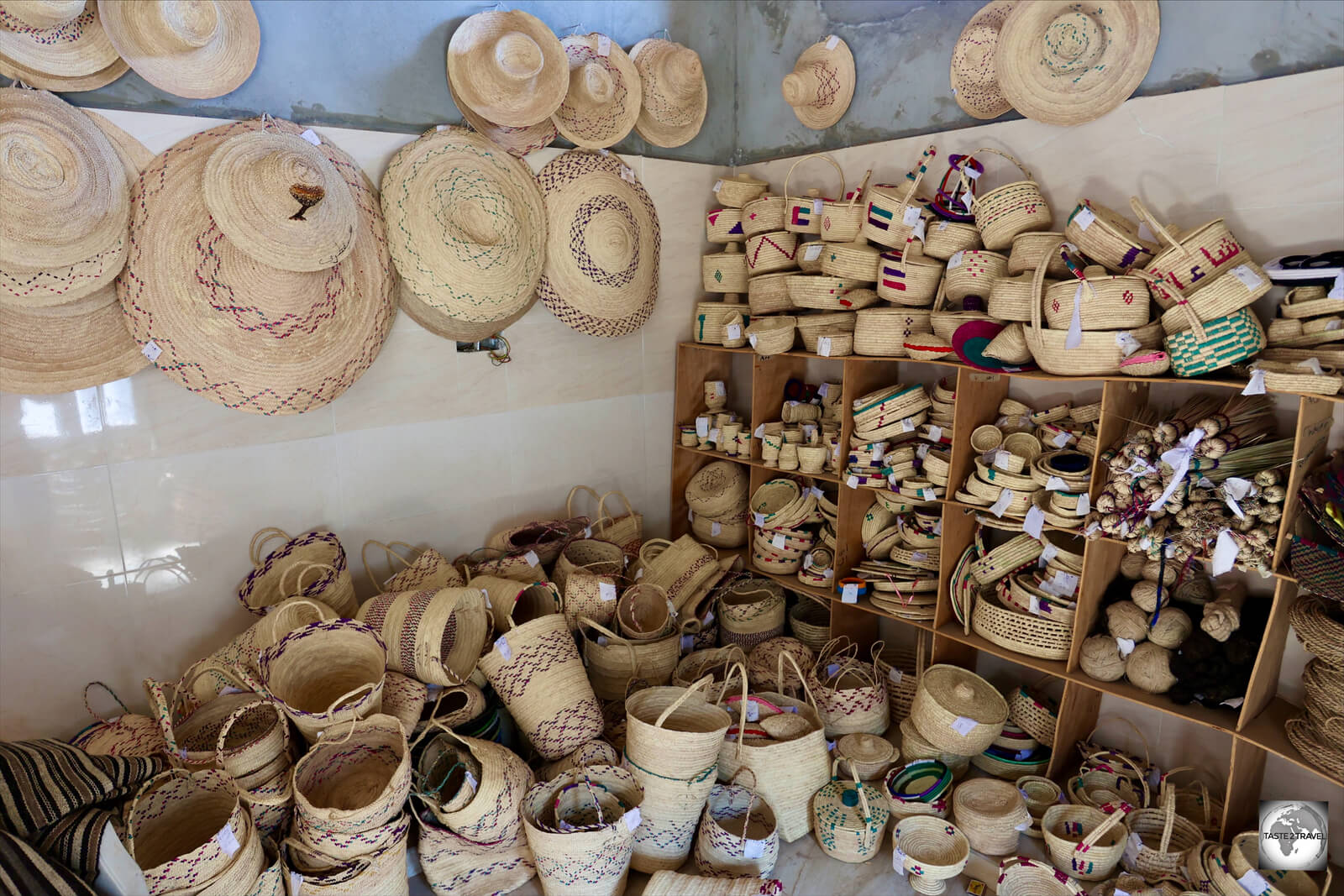
Handicrafts for sale at the Woman’s Co-operative in Hadiboh.
There are two places of interest which are the municipal fish market, which was built by the UAE government, and a Saudi-supported Women’s Co-operative where locally made handicrafts are offered for sale at very reasonable prices.
Di Hamri Marine Protected Area

A view of the coral-covered beach at the Di Hamri Marine Protected Area.
A short drive east of Hadiboh, the Di Hamri Marine Protected Area is home to an offshore coral reef and is the one place on Socotra where you can go diving with the one certified dive master on Socotra – the very friendly Naseem (Tel: +967 777 801 948).
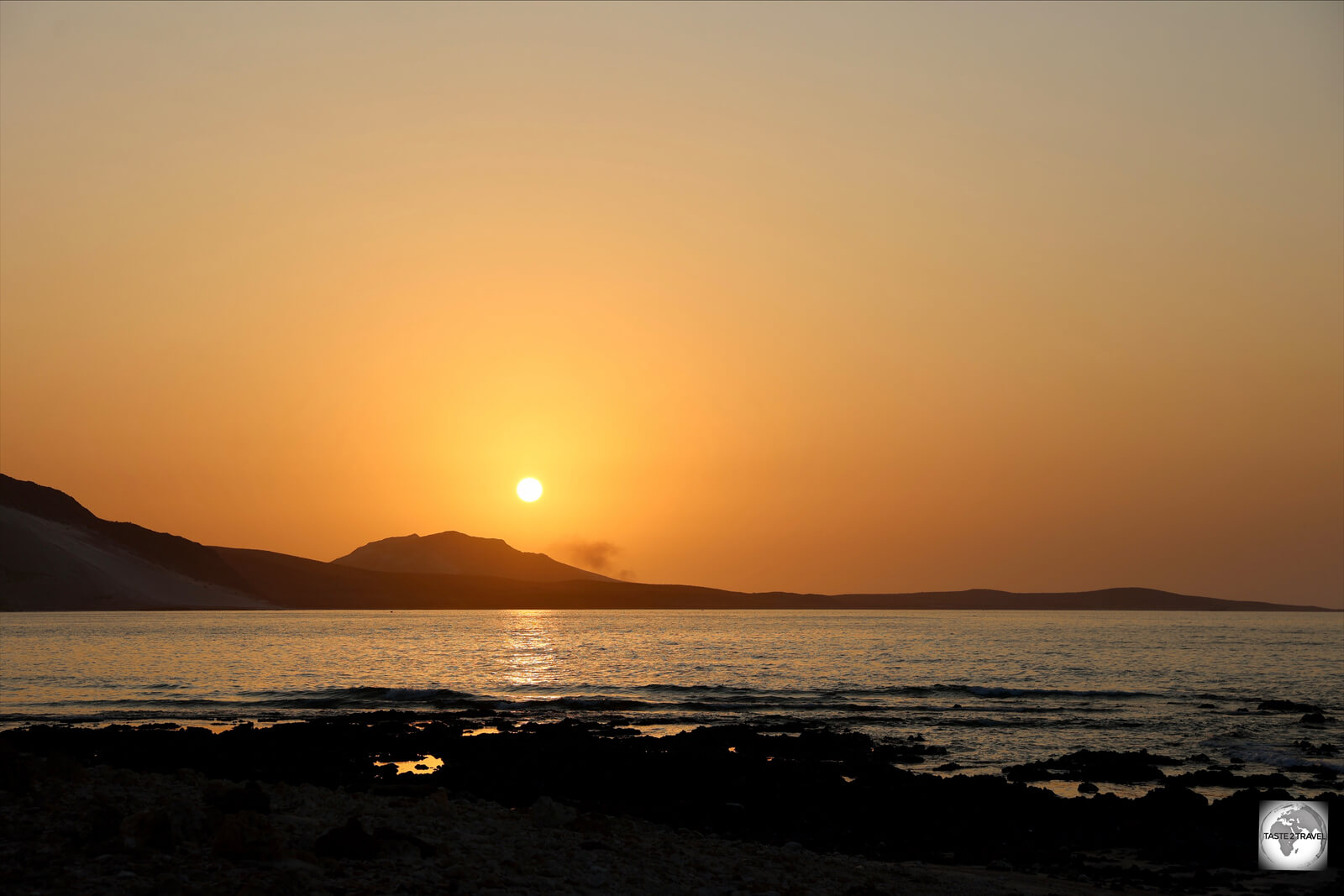
Sunset at the Di Hamri Marine Protected Area.
Located on a remote peninsula, Du Hamri is home to a small fishing. One of the residents of the village, Naseem, is the dive master.
A fulltime fisherman, Naseem has dive equipment, speaks English, and is happy to take tourists diving.
As a diver, I was keen to dive, but Naseem advised that visibility was very poor at the time of my visit (September) due to the ongoing monsoonal winds which were whipping the island every day during my visit.
He advised that the best months for diving are April and May.
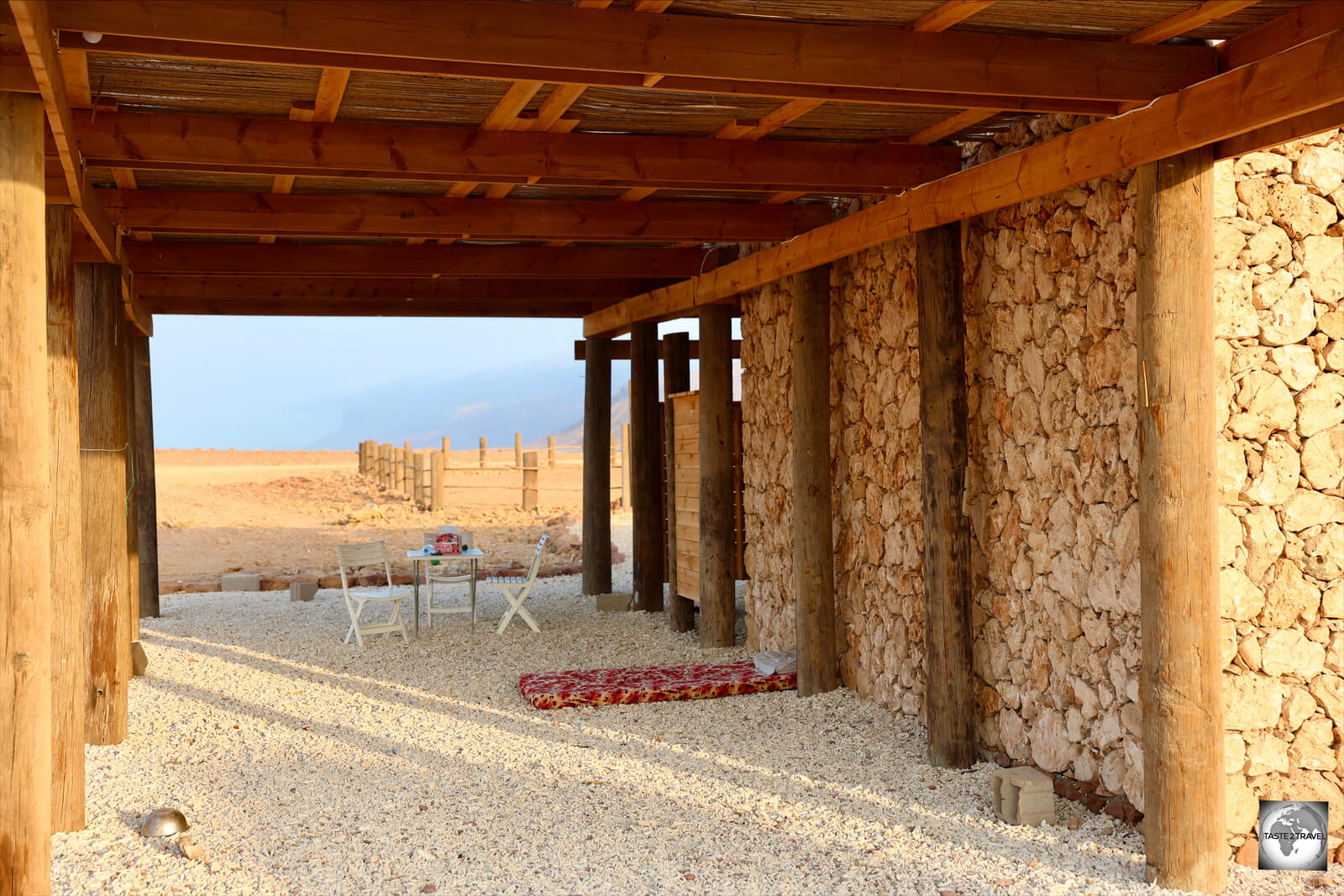
A red mattress, my bed for the night, at the Di Hamri Marine Protected Area, a campsite without any showers or toilets.
The campsite at Di Hamri contains one sturdy building which is currently under construction. I slept the night on a red mattress under the cover of the building, my first night of camping. At the time of my visit there were no facilities such as toilets, showers etc.
Wadi Kalysan

The most amazing freshwater pool on Socotra – Wadi Kalysan.
On the 2nd day of my 8-day trip, we drove from the Di Hamri Marine Protected Area to the remote Kalysan Canyon, which is close to the south coast, with views of the Indian Ocean in the distance.

A view of the Kalysan Canyon, with the Indian Ocean in the background.
A 45-minute hike down into the canyon ended at the stunningly beautiful Wadi Kalysan, where a river of bottle-green, fresh water flows through a canyon of white, polished limestone.

Bottle trees at Wadi Kalysan.
Once again – we had this amazing sight all to ourselves.

The green waters of Wadi Kalysan pass through the very remote Kalysan Canyon.
A great place to swim and relax while Abdulrahman (our driver and cook) prepared lunch back at the camp sight.

Wadi Kalysan – a perfect freshwater swimming pool.
Our driver and cook, Abdulrahman prepared the most amazing Kingfish for lunch at Kalysan Canyon.

Our driver and cook, Abdulrahman, prepared lunch at Kalysan Canyon.
The fish had been caught in the morning at Di Hamri by the dive master, Naseem, who had been out fishing earlier that morning.

Kingfish for lunch at Kalysan Canyon.
I chose to eat my lunch at the edge of the canyon, where I was joined by a number of opportunistic vultures.

My Kingfish lunch, with a view of the Kalysan Canyon and a vulture overhead.
Arher Beach Sand Dunes

A highlight of the east coast of Socotra are the towering white sand dunes which have been blown against the walls of the limestone massif at Arher beach.
A truly impressive sight are the towering white sand dunes at Arher beach.

Like large piles of talcum powder, the sand dunes at Arher beach are 150 metres (500 ft) in height).
Over millions of years, the strong winds which constantly whip the east coast, have blown the powdery white sand up against the cliffs of the limestone massif which runs along the coast.

The sand dunes of Arher beach, Socotra.
Yet another jaw-droppingly beautiful sight on an island which offers so many incredible views!

Sand dunes at Arher beach.
Truly Wow!

Our cave campsite at Arher beach.
Due to strong winds, our plan to camp overnight on the beach had to be abandoned. Instead, we camped in the shelter of a cave which overlooked the beach.

My guide, Ali, serving breakfast in the cave campsite.
Even in the shelter of the cave, the howling winds throughout the night tried their best to blow us all away.
Breakfast each morning usually consisted of flat bread (never fresh of course) with cheese spread and jam. This was served with a furnace of sweet black tea – delicious!

Sunrise over the east coast of Socotra, as seen from our cave campsite.
Hala Beach

Beautiful Hala beach, a typical beach on the east coast of Socotra.
Located on the east coast, a short drive from Arher beach, is the truly beautiful Hala beach.

The only house on Hala beach.
Yet another stunning beach with was deserted when we arrived.

A fisherman, fishing on Hala beach, Socotra.
I managed to take a few photos of the empty beach before a friendly fisherman appeared to demonstrate his fishing skills.

Hala beach – a perfect swimming beach with not a soul in sight – until the friendly fisherman appeared!
He managed to catch a very tiny fish, which he then stuffed in his pocket!

A fisherman at Hala beach, showing me his catch, before he put it in his pocket.
Homhil Plateau Protected Area

A panoramic view of the countryside from Homhil.
Day three saw us climb the first of many steep, rough gravel roads to the Homhil Plateau Protected Area.
Video: The drive down from Homhil.
Homhil is home to a stand of Socotra frankincense trees and many Dragon’s blood trees. Local villagers tap both trees to extract the valuable gum resin.

Frankincense trees on Homhil, Socotra.
Frankincense has been used since ancient times as an incense and fragrance. The Three Wise Men brought gold, frankincense and myrrh to the new-born king. Gold, of course, was valuable as currency, frankincense – a valuable perfume and myrrh – a precious ointment often used in the burial process.

Bottle tree on Homhil.
Today frankincense resin is sold around the world for incense production and religious ceremonies and is especially popular in the Middle East where it can be found in any souk.
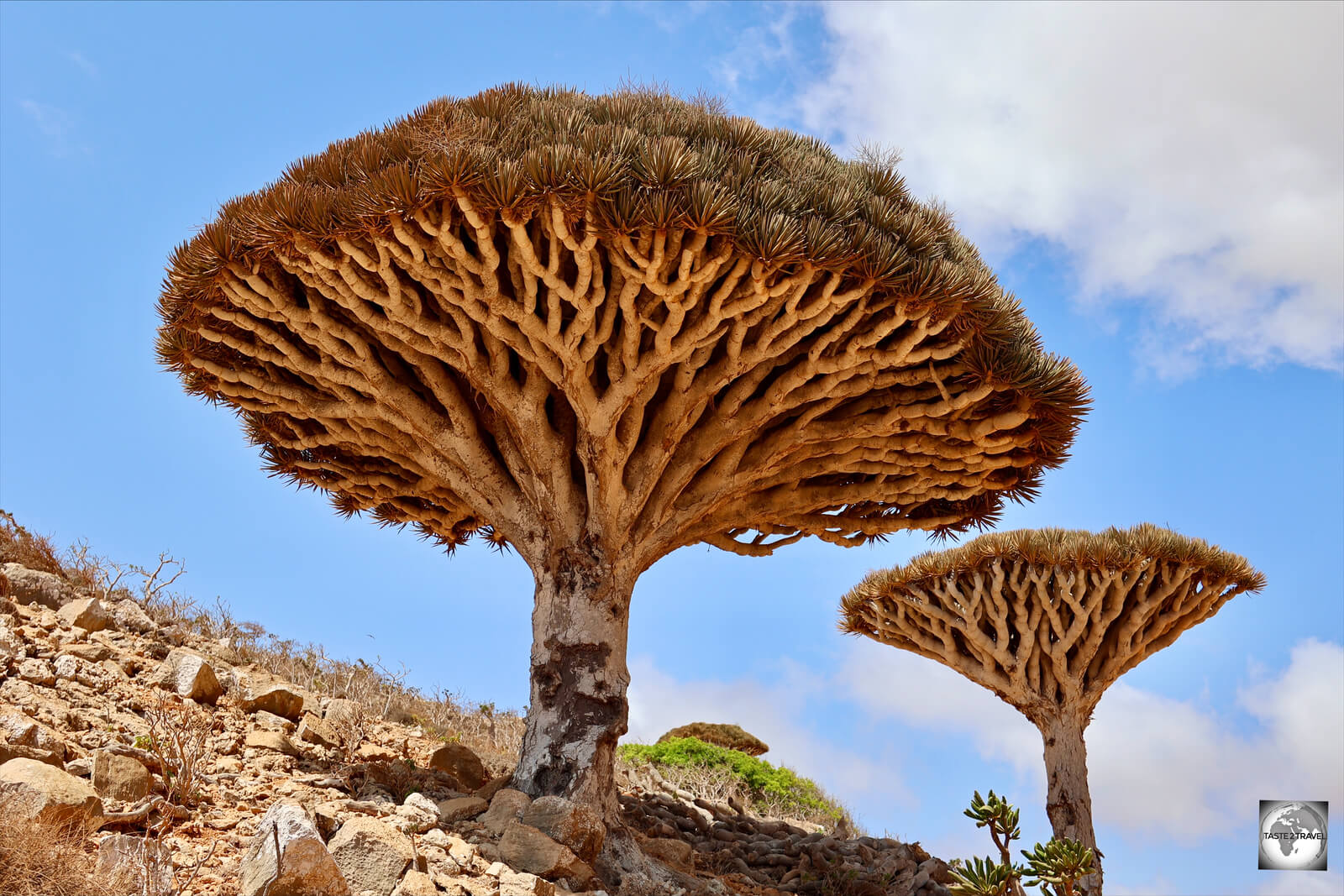
Dragon’s blood trees at Homhil.
Photography was best on Homhil since the trees were basking in glorious sunlight – unlike Diksam plateau which was always overcast and foggy.
Diksam Plateau

Dragon’s blood trees on Diksam plateau.
Diksam plateau is home to the largest stand of Socotra Dragon’s blood trees to be found anywhere in the world.

Children on Diksam plateau.
The weather during our two days was constantly overcast, foggy and wet.

Socotra Dragon blood’s trees on the edge of the 700-metre-deep gorge.
For the locals, who live on the dry coastal plain, where it rarely rains, visiting the plateau is a special experience. The cool, wet weather is truly a world away from the arid, blistering hot coast.

Exploring Diksam plateau with Socotra Eco-Tours.
The plateau is dissected by the 700-metre (2,295 ft) deep gorge which drops vertically to the valley floor.

Dragon’s blood trees on Diksam plateau.
On one side of the gorge is the Fermhin forest, home to the largest stand of Socotra Dragon’s blood trees.

My campsite at Diksam plateau.
The village at Diksam plateau is home to a campground which includes a couple of buildings for cooking and sleeping and a toilet and shower facility.
I chose to sleep outside, in a tent, under the protection of one of the buildings – out of the constant drizzle rain.
Dagub Cave

Standing in the entrance of Dagub cave, Ali and Mohammed provide a sense of scale for the two gigantic columns inside the cave.
On an island full of unforgettable sights, Dagub cave was another fascinating stop.
Set into the limestone escarpment which runs along the south coast, this large cavern is completely open to the elements which has resulted in the former stalactites and stalagmites becoming discoloured due to exposure to oxygen and the elements.

The view from within the massive Dagub cave.
The entrance of the cave features two massive columns (i.e. a structure where stalactites and stalagmites have joined together to form a single column). These columns are easily 20 metres in height.
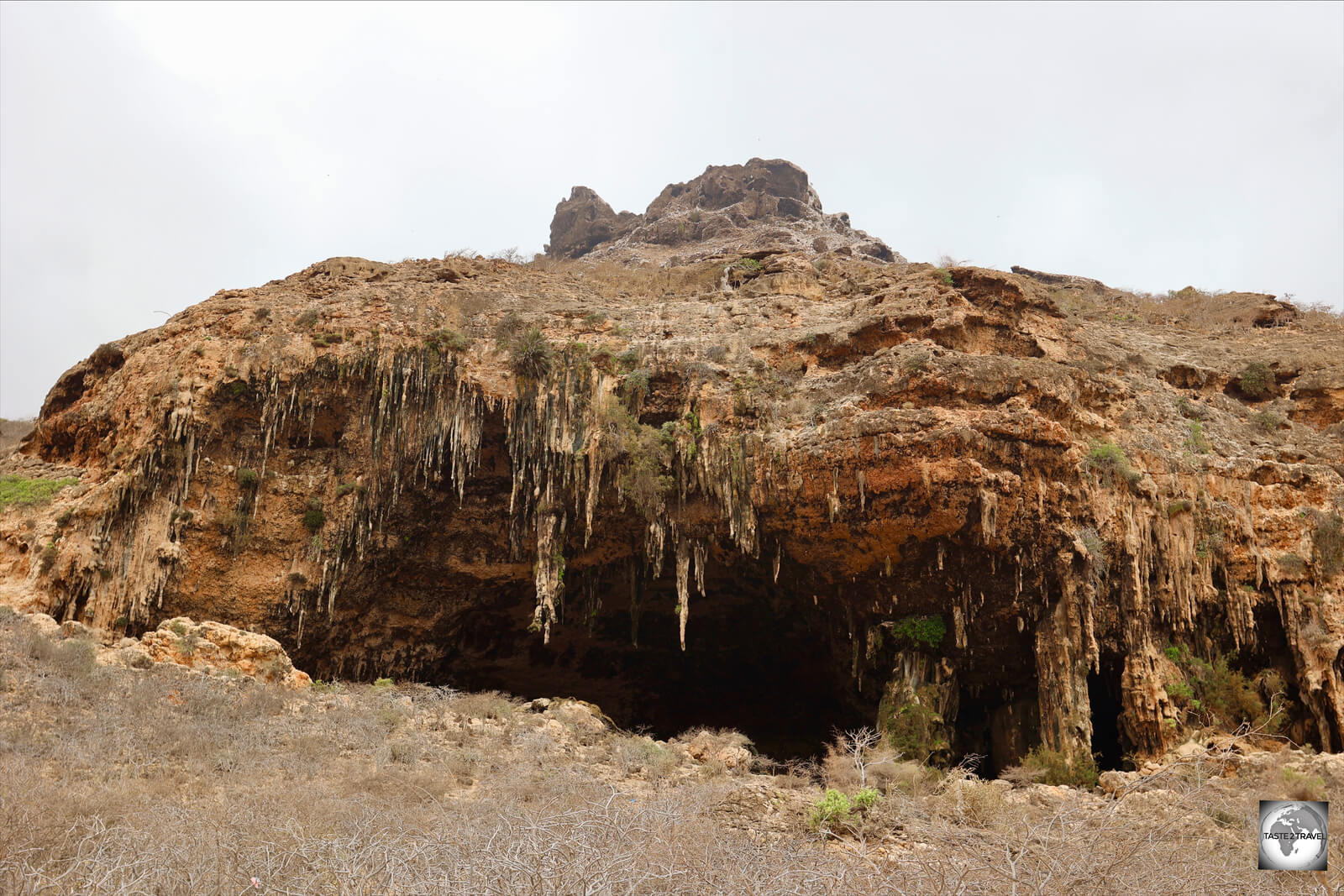
Dagub cave is set in the limestone escarpment which runs along the south coast.
Considering that stalactites and stalagmites grow at approximately 2.5 cm (1 inch) per 1,000 years, these were formed over many millions of years. Today they lie exposed to the elements with vegetation sprouting from them.

The floor of Dagub cave is carpeted in a thick layer of Guano.
Also impressive is the fact that the floor of the cave is completely covered in a thick layer (a least 10 cm) of guano from the many bats and birds which inhabit the caves, the result of millions of years of pooping!
Amazing to see such a valuable resource lying untouched. Only on Socotra!
Amek Beach

Located on the south coast, Amek beach served as our campsite for one night. I got to dine, and sleep, in this newly purchased tent which was wonderful.
Our campsite on the rugged south coast of Socotra was on Amek beach.
The long, exposed beaches on the south coast are pounded by the rough, turbulent waters of the Indian Ocean.
Swimming here is dangerous due to rips and currents.
The best swimming beaches on Socotra are on the north and east coasts which face the much calmer Arabian sea.

The campsite at Amek beach, on the south coast of Socotra.
The campsite at Amek beach features the usual rudimentary structures (no good if it starts raining!) plus an amenities block (pictured in the background) with pit toilets and showers – which are placed directly above the pit toilets!

A curious camel, checking me out, on Amek beach.
Hayf and Zahek Sand Dunes

The magnificent and surreal sand dunes on the south coast of Socotra.
A highlight of the south coast is the beautiful and totally surreal Hayf and Zahek sand dunes. Best photographed early morning or late afternoon when the light is especially moody.
Truly stunning and very special to have such a place to yourself!

Dramatic skies over the Hayf and Zahek sand dunes.

Incredible sand designs and stormy skies at the Hayf and Zahek sand dunes.

A photographer’s dream – the incredible Hayf and Zahek sand dunes.

One more image from the Hayf and Zahek sand dunes.
Qalansiya

A school girl in Qalansiya.
Located at the far western end of Socotra, facing out towards Somalia and Africa, the island’s 2nd largest town, Qalansiya, is a sleepy settlement with nothing too redeeming to offer.

With a population of 4,000 – Qalansiya is the 2nd largest town on Socotra.
Most people drive through the dusty streets of sleepy Qalansiya, on their way to the nearby Detwah Lagoon.
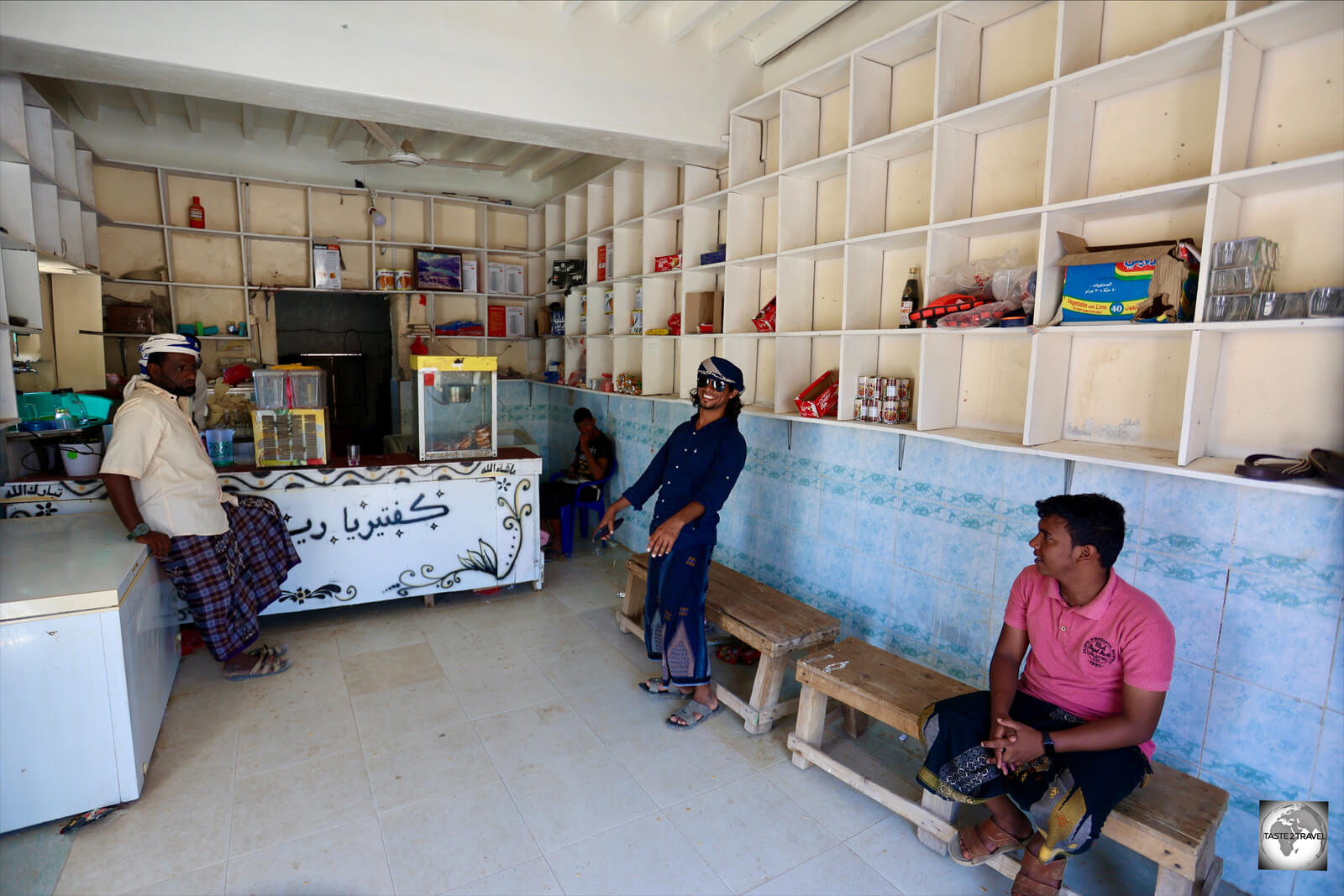
I treated the tour company staff to a delicious lime juice at this shop in Qalansiya.
One stop worth making in Qalansiya is at the local juice shop. I treated the guys to a jug of freshly blended Socotra lime juice – so good in the baking midday heat.
Detwah Lagoon

On an island full of stunning beaches, the beach at Detwah Lagoon is possibly the best!
Wow! Wow! Wow! What a stunning sight!
After a week of driving around Socotra and photographing one amazing beach after another, the finalé came in the form of the spectacular Detwah Lagoon and the adjacent beach, both of which are tucked away behind a rocky hill which rises up behind the town of Qalansiya.

The locals on Socotra do not have a swimming culture and with no development anywhere, the stunning beaches on the island are always empty.
What an amazing sight – and absolutely deserted!
Of course, I had to go for a swim. An incredible experience to have such an amazing beach to myself. Anywhere else in the world, this would be lined with hotels and crammed full with bathers!

With its large granite boulders, the beach at Detwah Lagoon reminded me of beaches in the Seychelles.
Only on Socotra can you have such an idyllic beach to yourself.

An amazing beach to have to yourself!
Alongside the beach is Detwah Lagoon which is home to one family who fish and operate an informal campsite which is used by the different tour companies.

A view of Detwah Lagoon.
From the beach I walked to the campsite which overlooks the beautiful Detwah Lagoon.

A panoramic view of the Detwah Lagoon.
Like other campsites on Socotra, this campsite consists of a few rudimentary structures which allow you to keep out of the blistering sun during the day.

The campsite at Detwah Lagoon where I dined on freshly caught crab for lunch.
The campsite is operated by a young fisherman and his family, who live in the only house to be built on the shores of the lagoon.

The fisherman, who operates the campsite at Detwah Lagoon, offered me a freshly caught crab for lunch.
The fisherman offered me a crab which he had caught in the morning. This was an extra charge for which I paid US$4 – a charge which was totally worth it!

My lunch at Detwah Lagoon included a freshly caught crab.
My crab was served with a plate of rice and pieces of fresh tuna – which were overcooked.
All food on Socotra is served ‘well done’.

The fisherman at Detwah Lagoon showing me a baby stingray which inhabits the lagoon.
The shallow waters of Detwah lagoon provide the perfect nursery for cute baby stingrays. The fisherman showed me one juvenile ray which had a stinger in its tail.

A view of Detwah Lagoon at low tide.
If you’re walking around in the lagoon, its best to shuffle your feet, rather than stepping, which helps to stir up the sandy floor and will force any lurking rays to move on.
Qoba Crater Lake

A view of the Qoba crater lake which lies on the north coast.
Located on the north coast, a short drive from the main road, the Qoba crater lake is an enigma. No one seems to know when this was formed, but the saline water attracts local livestock.
Hajhir Mountains

The lofty peaks of the Hajhir Mountains are often shrouded in cloud.
Forming a towering backdrop to Hadiboh, the Hajhir massif is the highest mountain range on Socotra Island. The highest point of the range is Mashanig peak which lies at approximately 1,500 m (4,900 ft) above sea level.
The road up to the top of the range is a very steep, poorly maintained gravel road which becomes slippery mud as you enter the fog/ cloud zone near the summit of the range.
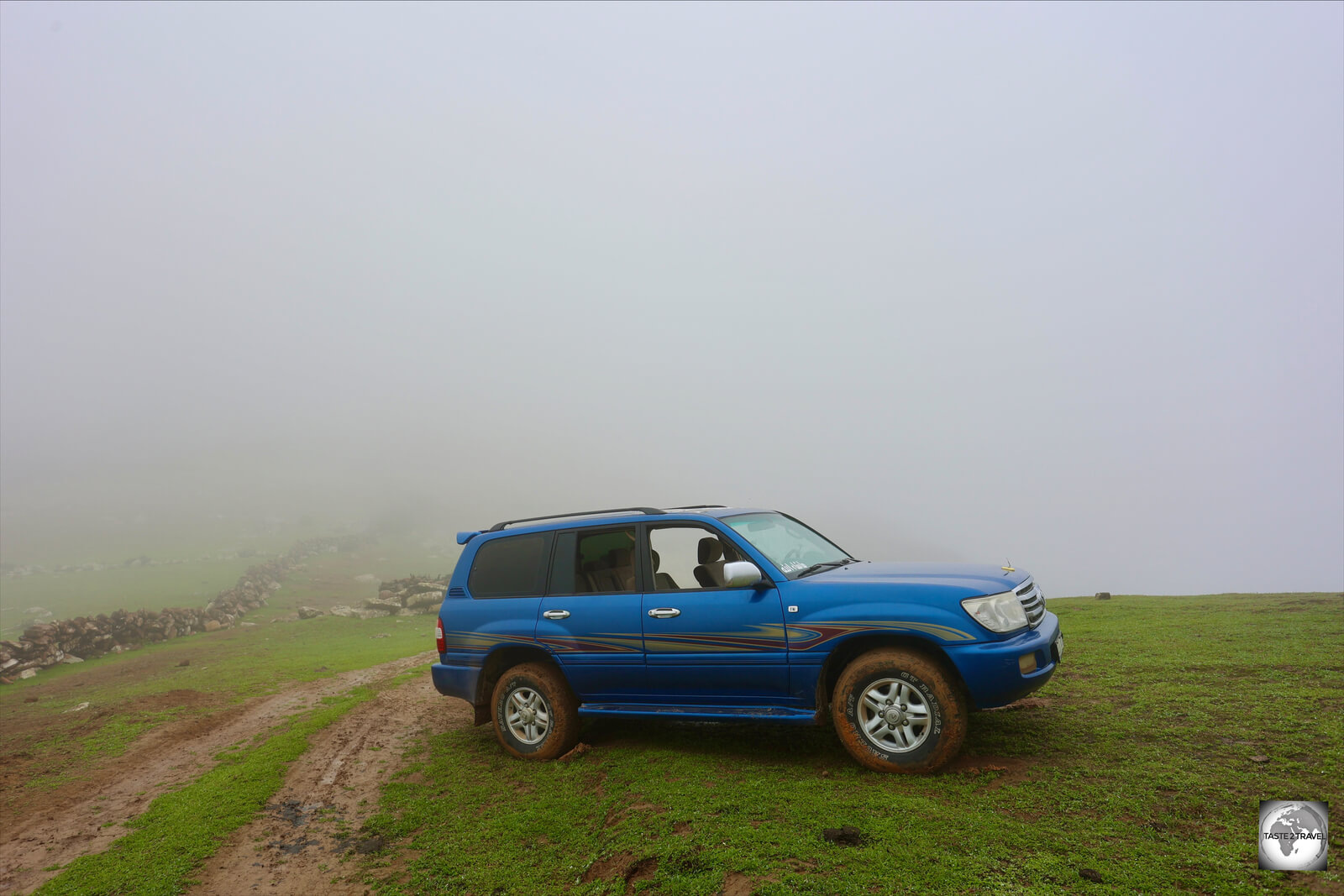
Our 4WD, shrouded in fog and cloud, at the top of the Hajhir Mountains.
It’s best to check the cloud condition before driving to the top, and best not to go when cloud covers the mountains, although weather conditions at the summit change every 5 minutes.

A view down to the north coast from the Hajhir Mountains.
The drive up the steep, perilous gravel/ mud road takes almost one hour. If the mountain is covered in cloud, there is little to see!
Accommodation

My room at the Diamond hotel in Hadiboh costs US$30 per night.
Socotra Island is largely undeveloped and has been bypassed by the modern age. As such, the standard of everything, including accommodation, cannot be compared to the modern world.
Hotels are generally basic and camping grounds are very rudimentary.
Hotels
There are a few hotels in the main town of Hadiboh but no accommodation options elsewhere. Most tours include a hotel on the last night so you can freshen up before your flight the next morning.
Those who do not wish to participate in camping can instead stay in hotels in Hadiboh and do daytrips each day. This option will cost you extra.
The island is small enough that it can be covered on day trips from Hadiboh.
The following hotels are located in Hadiboh:
- Summerland Hotel: the fanciest accommodation on Socotra with rooms starting at US$75.
- Diamond Hotel: a good mid-range option with rooms starting at US$30.
- Socotra Tourist Hotel
- Taj Socotra Tourist Hotel: Tel: +967 5 660 626
Camping

This cave on the east coast served as our campsite one evening.
While camping trips are the norm on Socotra, there are few established camping grounds. In some places, rudimentary shelters have been erected with very basic toilet and shower facilities. In other places, you camp rough, maybe inside a cave.
Eating Out
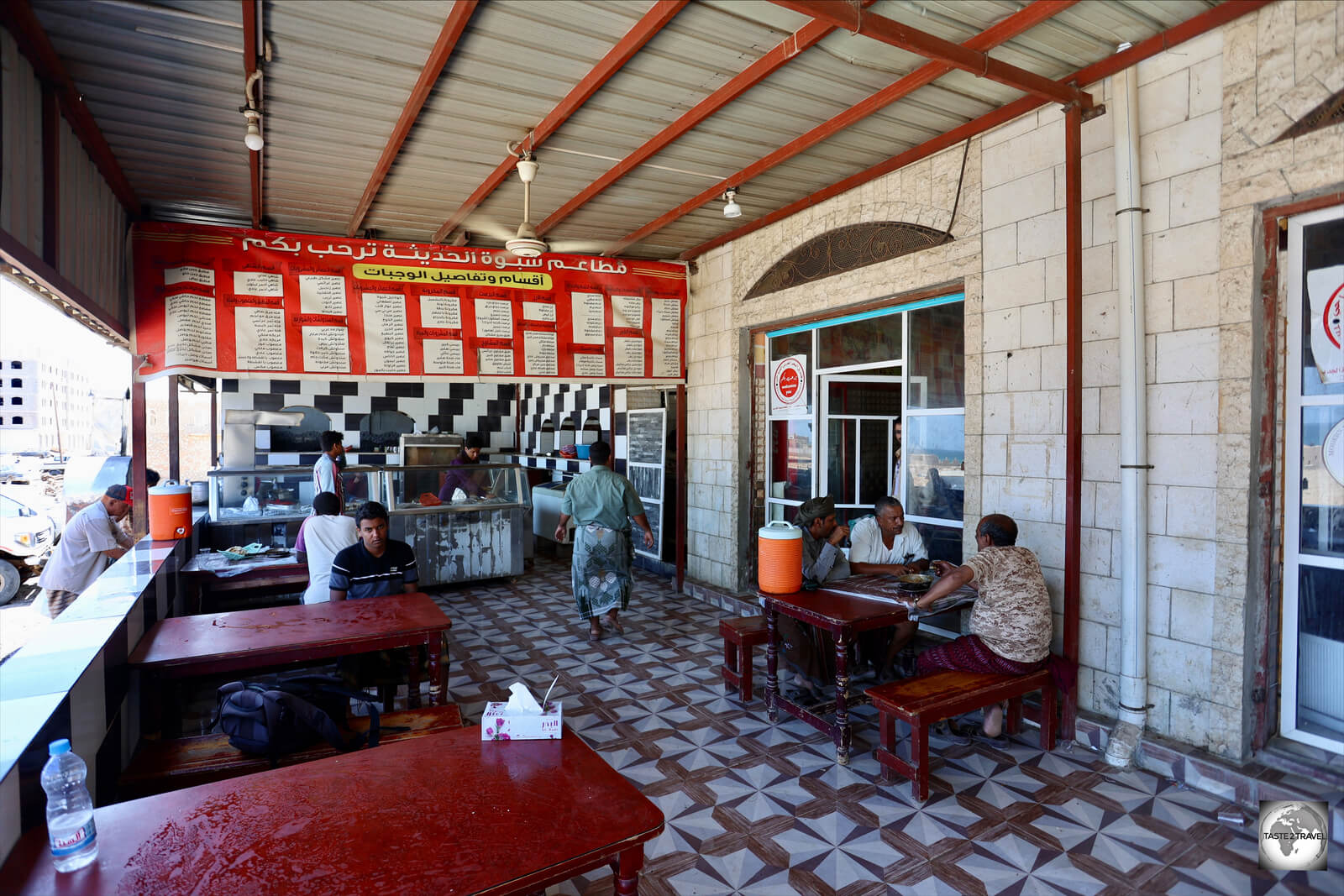
The best restaurant in Hariboh, the popular Shabwah Restaurant.
In Hadiboh, dining options are very limited, but everywhere you can find sweet, black tea.

A tea shop on Socotra. Tea, or chai is an integral part of life on Socotra.
The most popular restaurant in town is the Shabwah Restaurant which is where all tourists end up dining.

Sharing breakfast, and the largest piece of flatbread I’ve ever seen, at the Shabwah restaurant with my guide Ali.
During my stay on the island, eggs had not been available for weeks. On my last day, eggs were back on the menu at the Shabwah restaurant thanks to a boat which had arrived the day before.

Most meals on Socotra consist of rice with some sort of protein, normally freshly caught fish.
With almost all food imported by dhow boat from mainland Yemen, the island suffers food shortages during the windy season when boats are often cancelled.

Goats are everywhere on Socotra and love to steal your food (or anything else) while you have your back turned.
Special mention should be made of the large number of goats on Socotra – they easily outnumber the human population.
As cute as they look, the free-roaming goats are very mischievous and will steal any food whenever you have your back turned.
This is a problem since all meals on a camping trip are eaten outdoors. The goats are ever-present and will strike whenever you let your guard down.
Shooing away goats is a national pastime on Socotra. Very annoying!
Lime Juice

A deliciously refreshing, icy cool, freshly blended, lime juice in the town of Qalansiya.
Something that should not be missed while on Socotra is the deliciously fresh lime juice, which is freshly blended using Socotra limes.

A blender full of delicious lime juice at a shop in Qalansiya.
The best lime juice on the island can be found at a juice shop in the smaller town of Qalansiya and at the Shabwah Restaurant in Hadiboh.
Visa Requirements

My departure stamp from Socotra.
Almost all nationalities require a visa to visit Yemen.
Currently, 11 nationalities can obtain a visa on arrival. To check your visa requirements, you should refer to the Visa Policy of Yemen.

My Yemen tourist visa.
Visas are included in the cost of a tour and will be emailed to you by your tour operator. The visa needs to be printed and presented upon arrival at Socotra airport.
Upon arrival at Socotra, your passport will be stamped and the bottom section of the visa form will be detached, stamped and handed to you. It’s important to retain this part of the visa which will need to be surrendered upon departure.
Getting There

A view of Socotra Airport.
Air

Air Arabia operate the weekly UAE government charter flight from Abu Dhabi airport.
Just two airlines provide flights to Socotra:
- Emirates Aviation Services (UAE government charter flight which uses an Air Arabia airbus): Flies to/ from Abu Dhabi every Tuesday.
- Yemeni Airways: flies to/ from Cairo every Wednesday.

A view of Socotra from my Air Arabia flight.
Getting Around

Transport on Socotra is provided by your tour company.
All transport on Socotra is provided by your tour company.
Public transport is very limited with a few minibuses providing infrequent services for locals. Most locals tend to hitch rides by waiting by the roadside.

A Socotra car license plate.
Signage is totally non-existent on the island and with no WiFi signal, navigation apps do not work!
That’s the end of my travel guide for Socotra. If you have any feedback, please do not hesitate to leave a reply below.
Safe Travels!
Darren
Socotra Travel Guide Socotra Travel Guide Socotra Travel Guide Socotra Travel Guide Socotra Travel Guide Socotra Travel Guide
Socotra Travel Guide Socotra Travel Guide Socotra Travel Guide Socotra Travel Guide Socotra Travel Guide Socotra Travel Guide
Socotra Travel Guide Socotra Travel Guide Socotra Travel Guide Socotra Travel Guide Socotra Travel Guide Socotra Travel Guide
Socotra Travel Guide Socotra Travel Guide Socotra Travel Guide Socotra Travel Guide Socotra Travel Guide Socotra Travel Guide
Author: Darren McLean
Darren McLean is an Australian, full-time, digital nomad who has spent 37 years on a slow meander around the globe, visiting all seven continents, 192/ 193 UN countries and 245/ 251 UN+ countries and territories.
He founded taste2travel to pique one’s curiosity and inspire wanderlust.

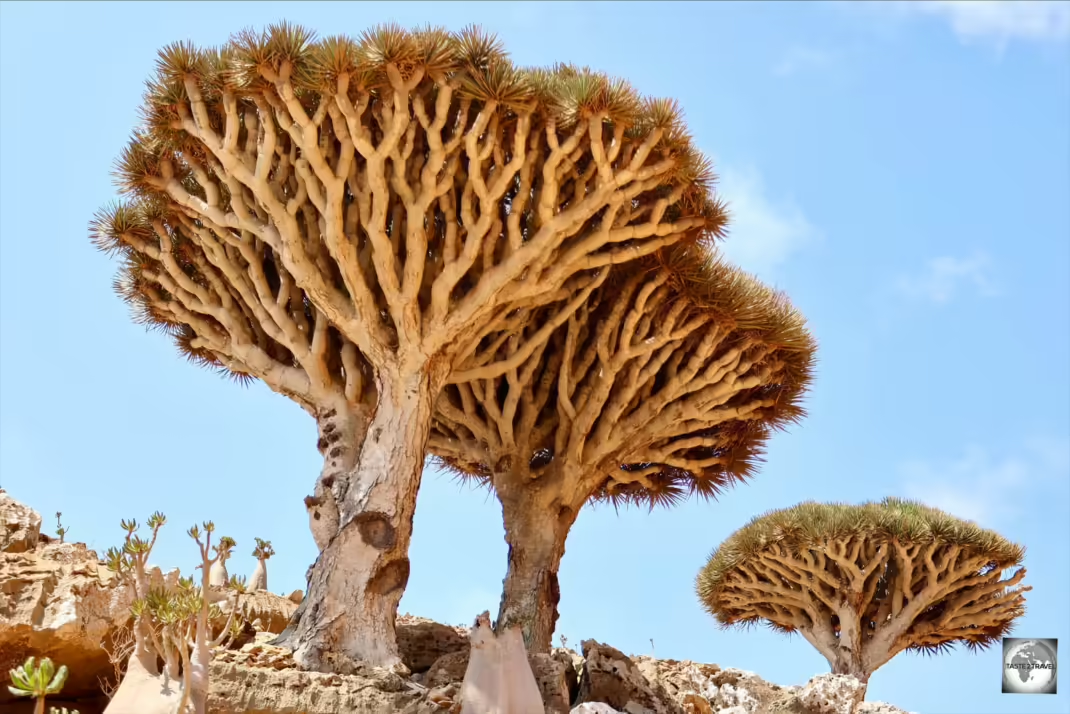






Thanks for the very complete guide to Socotra… good to see an Aussie moving beyond the regular places.
I am going there in March — I’m excited.
As a funny note, it will not complete the 246 or 197 (depending upon which list you follow), but it WILL mean I have done at least 1 country of every letter of the alphabet (not including X).. 🙂
Hi Peter,
… not including ‘X’ or ‘W’… haha!
I follow a list of 246 countries and (populated) territories which can be downloaded from my website – it’s an editable Excel spreadsheet which readers can use to keep track of their country (and territory) count.
Thanks for the positive feedback regarding my Socotra Travel Guide. It’s an amazing destination. Enjoy your time there!
Safe Travels!
Darren
Was a fabulous trip.
Hi Peter,
Happy to hear you had a great trip.
Regards,
Darren
Nice guide explored so many things. thanks for sharing its worth it.
Hi Sachleen,
Many thanks for your positive feedback, I appreciate it very much.
Are you planning a trip to amazing Socotra?
Safe travels!
Darren
Hello Dareen!
I really really enjoyed your report it was full of information. I was wondering do you have more photos to share?